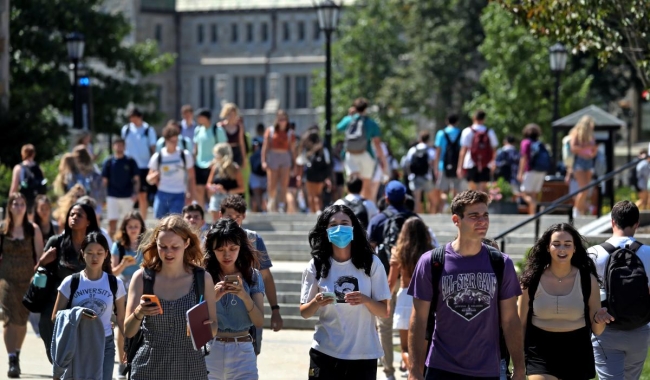You have /5 articles left.
Sign up for a free account or log in.

David L. Ryan/The Boston Globe via Getty Images
Pell Grant recipients are increasingly finding fewer affordable options for college and higher financial unmet needs, the National College Attainment Network found in a new analysis.
Nationally, 24 percent of public four-year colleges or universities were considered affordable for the average Pell Grant recipient, along with 40 percent of two-year public community colleges. The National College Attainment Network considers a college or university to be affordable if the total cost of attendance, plus $300 for emergency expenses, doesn’t exceed the sum of financial aid, family contributions and student wages. The association, which works to close equity gaps in postsecondary attainment, has tracked college affordability data using its formula since 2018.
At four-year institutions, the average Pell Grant recipient needed an additional $2,627 to pay for tuition, fees and living expenses for the 2019–20 academic year—the most recent year with complete data at the time of the report’s release. At two-year institutions, the unmet financial need, or affordability gap, was $907.
“They’re not good results,” said Raymond AlQaisi, senior manager of policy and advocacy for the National College Attainment Network. “Less than a quarter of public four-year institutions were affordable. Less than half of public community colleges are affordable. These are the postsecondary options that we tell students are affordable, and our research shows that they are not generally affordable.”
About 29 percent of four-year institutions and 50 percent of two-year institutions were considered affordable when NCAN released its first version of the report for the 2015–16 academic year. Trends have since continued in the “wrong direction,” said AlQaisi, who authored the report.
“I don’t think we stress enough that this report assumes that students are contributing earnings from full-time work in the summer and part-time work the rest of the year to offset the cost of attendance, and that’s not a really reasonable assumption for all students,” AlQaisi said. “It’s possible that our model overstates the number and share of higher education institutions that are affordable.”
For the 2019–20 academic year, California, Georgia, Texas and Washington had the highest number of affordable institutions, while four states—Hawaii, New Hampshire, Rhode Island and Utah—had no affordable institutions, according to the report. The number of institutions considered affordable dropped in 21 states since the 2015–16 academic year.
The results underscore the persistent challenges students face affording college, he wrote in the report.
“Too many students and their families worry, justifiably so, about how to afford postsecondary education,” NCAN CEO Kim Cook said in the news release. “And for students to earn the postsecondary credentials they need for the jobs of the future, they have to be able to afford it. These findings reflect a sad state of college affordability, even before the COVID-19 pandemic, and should sound the alarm across the country.”
NCAN and other organizations have pushed Congress to double the maximum Pell Grant to $13,000 to better support students. The federal grant program hasn’t kept up with inflation or the rising costs of college, they argue. The majority of Pell Grant recipients come from low-income backgrounds, and the grant covered 26 percent of the average cost of attendance at a public four-year institution, according to the National Association of Student Financial Aid Administrators.
Congress recently boosted the maximum Pell Grant by $400 to $6,895 for the current academic year. That increase was the largest in a decade, AlQaisi said, and congressional lawmakers are considering another $500 bump, which could be part of an omnibus funding package that’s expected in December.
“We’re hoping to see a big bump in the Pell Grant knowing that this can help bring us in the right direction on college affordability,” AlQaisi said.








